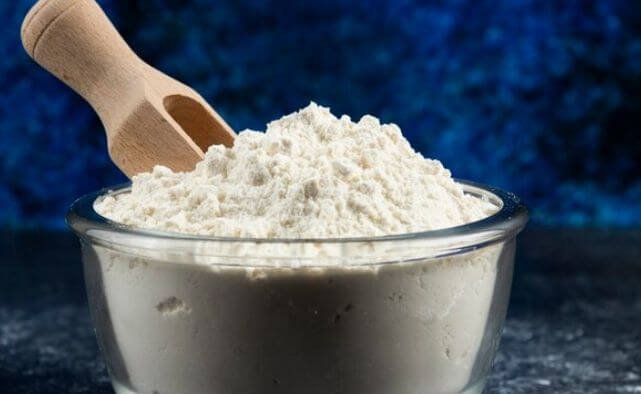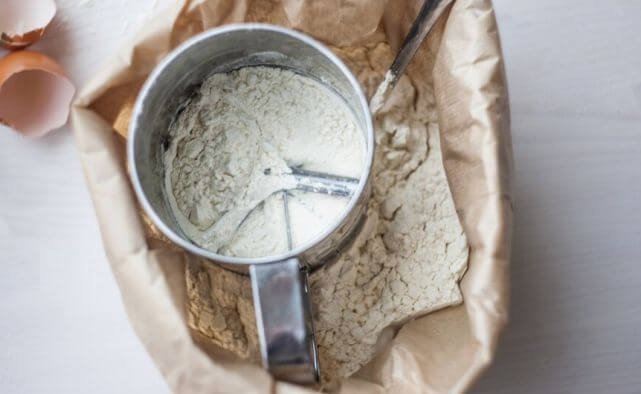Let’s examine the chemical modification of tapioca starch, a process that improves its functional properties for various industries. Learn about key modification techniques and their applications in food, paper, and pharmaceuticals.
The natural properties of tapioca starch limit its functionality. Chemical modification of tapioca starch has become necessary to improve its stability, texture, and performance under various conditions.
By altering its molecular structure, modified tapioca starch finds broader applications, from thickening sauces to improving paper strength.
This article will discuss the different types of chemical modifications, their benefits, and how they transform tapioca starch into a more effective and adaptable material across multiple industries.
Tapioca starch, derived from the cassava root, holds immense importance in various industrial applications due to its special properties.
However, its natural form may not always meet the specific requirements across different sectors such as food processing, pharmaceuticals, and textiles.
Therefore, the chemical modification of tapioca starch emerges as a welcomed technique aimed at improving its functional properties.
By altering the structural characteristics of the starch at a molecular level, these modifications help to have greater usefulness and performance in application.
Related: Difference between Tapioca Starch and Tapioca Flour
Key Takeaways
- Chemical modification of tapioca starch improves its stability, texture, and performance, making it useful in a range of applications for industries like food processing, textiles, and pharmaceuticals.
- Techniques like oxidation, cross-linking, and acetylation alter tapioca starch’s molecular structure, improving its solubility, viscosity, and heat resistance for various applications.
- Chemically modified tapioca starch provides improved gel strength and film-forming capabilities, leading to biodegradable packaging and better-quality food products with improved textures.
- From improving paper strength to providing smooth textures in food, chemically modified tapioca starch offers crucial functional advantages across multiple sectors.
Table of Contents
- Key Takeaways
- Why Modify Tapioca Starch Chemically?
- Types of Chemical Modifications of Tapioca Starch
- Oxidation
- Acid Hydrolysis of Tapioca Starch
- Cross-Linking of Tapioca Starch
- Acetylation
- Etherification
- Benefits of Chemical Modification of Tapioca Starch
- Conclusion
Why Modify Tapioca Starch Chemically?
The primary purpose of chemically modifying tapioca starch is to improve its functionality to better suit specific needs.
For instance, modifications can lead to improved solubility, better thickening ability, increased stability, and enhanced texture.
These properties render modified tapioca starch an invaluable ingredient in the formulation of various products.
In the culinary sector, for example, modified starches can be used to achieve desired textures in sauces, soups, and desserts, while in the pharmaceutical industry, they may serve as excipients that facilitate the delivery of active ingredients.
Research has shown that through various chemical modifications, such as:
- Acetylation
- Cross-linking, and
- Oxidation
….the performance of tapioca starch can be enhanced. This helps manufacturers to tailor properties to meet the specific demands of their products.
As the industries continue to evolve, understanding the implications of chemical modification becomes important, ensuring that tapioca starch meets the changing needs of consumers and businesses alike.
In light of its wide-ranging applications and the continual advancements in the techniques used for its modification, exploring the chemical modification of tapioca starch is not only about the improvement of its functional properties but also about unlocking its full potential across various fields.
Related: What is Resistant Tapioca Starch?
Types of Chemical Modifications of Tapioca Starch
Chemical modification of tapioca starch involves several methodologies, each employing specific processes to enhance the functional properties of the starch.
One of the notable methods is oxidation, which introduces oxidizing agents into the starch to create a range of oxidized products.
This modification improves the gelatinization temperature and increases the solubility of starch, making it suitable for applications in food industries where these properties are critical for creating sauces and dressings.
Another method is acid hydrolysis, wherein starch is treated with an acid to break down the polymer chains.
Related: What is Tapioca?
This process reduces the viscosity of the starch and improves its digestibility, thereby making it more beneficial in low-calorie food products.
It finds extensive applications in the production of snacks and dough, where altered texture and solubility are desirable.
Cross-linking is another prominent modification technique. By joining individual starch chains through the use of cross-linking agents, the stability and resistance to retrogradation are significantly enhanced.
This results in improved performance in food systems that require heat stability and freeze-thaw cycles, making it valued in both food processing and paper manufacturing.
Let’s take a closer look at them individually:
Related: Best Tapioca Substitutes
Oxidation

Oxidation is a method of chemical modification that alters the structural properties of tapioca starch, which is derived from the cassava plant.
This process involves the treatment of starch with oxidizing agents such as sodium hypochlorite, hydrogen peroxide, or ozone.
These agents facilitate the breakdown of molecular chains within the starch, leading to changes in its inherent characteristics.
The oxidation process generally enhances the whiteness, solubility, and viscosity of the starch, making it more appealing for various applications.
Related: Tapioca What is it Made From and Made of?
Benefits of the Chemical Oxidation of Tapioca Starch
One of the primary effects of oxidation is the increased whiteness of the modified starch. This improved aesthetic quality is important in industries such as food production, where visual appeal can significantly influence consumer choices.
Additionally, oxidation impacts the viscosity of tapioca starch. The modified starch usually exhibits lower viscosity, which can be beneficial in applications requiring improved texture or mouthfeel, such as in sauces, dressings, and other processed foods.
The effect on viscosity also allows for easier incorporation of starch into formulations, which can enhance the overall quality of food products.
Beyond the food industry, oxidized tapioca starch finds utility in papermaking. Its altered physical properties contribute to better paper strength and improved surface quality.
The enhanced binding properties of oxidized starch provide significant benefits, facilitating better adhesion of fibers during production.
Furthermore, it aids in the coating of paper, yielding a desirable finish for printing and packaging applications.
Related: Tapioca Starch Industry Trends
Acid Hydrolysis of Tapioca Starch

Acid hydrolysis is a chemical modification process applied to tapioca starch that alters its structural characteristics and functional properties.
In this process, hydrochloric or sulfuric acids are used to break down the starch polymer chains into smaller fragments.
This process affects the degree of polymerization, facilitating changes in both the physical properties and the behavior of the starch in various applications.
During acid hydrolysis, the crystalline structure of tapioca starch is disrupted, leading to the gelatinization phenomenon where the granules swell and dissolve in hot water.
This transformation is needed to improve the starch’s ability to function as a thickening agent in different culinary applications.
Post-hydrolysis, the starch exhibits improved solubility and viscosity, making it suitable for incorporation into diverse products.
One of the primary applications of hydrolyzed tapioca starch is in the confectionery industry, where its modified properties allow for better texture and mouthfeel in sweets and candies.
For instance, the use of acid-modified starch improves the elasticity and chewiness of gummy candies, as well as contributes to the desired consistency in marshmallows and other chewy confections.
Furthermore, its thickening capabilities are harnessed in sauces, gravies, and soups, providing a desirable viscosity and stability to these products.
Also, the application of hydrolyzed starch extends to its use as a food thickener. In various food systems, this starch helps to achieve the right balance of texture while maintaining a smooth and palatable feel.
The altered properties enable manufacturers to design food products with specific qualities, making acid-hydrolyzed tapioca starch an integral component in modern food technology.
Related: How to Make Tapioca Flour and Tapioca Starch
Cross-Linking of Tapioca Starch

Cross-linking is a process that involves the formation of covalent bonds between the hydroxyl groups of starch molecules, which helps to create a three-dimensional network.
The most commonly used cross-linking agents include epichlorohydrin, phosphorus oxychloride, and sodium trimetaphosphate.
Each of these agents interacts with starch granules, facilitating the cross-linking reaction under controlled conditions of temperature and pH.
The primary advantage of cross-linking is the enhanced stability it provides to modified tapioca starch.
By reinforcing the structure of starch, cross-linking improves its resistance to heat, shear, and other mechanical stresses.
This stability is particularly beneficial in food processing, where harsh conditions are often encountered.
For instance, cross-linked tapioca starch exhibits improved viscosity and texture retention even when subjected to prolonged heating or stirring, which are common in processes such as making sauces or canned foods.
Also, cross-linking influences the water absorption capacity of tapioca starch. The modified starch can maintain its thickening ability without losing its gel structure, which is crucial in applications where a stable and consistent texture is required.
This characteristic makes it highly valuable for sauces, gravies, and soups that demand a smooth and homogeneous consistency without separation over time.
In addition to food applications, cross-linked tapioca starch is also utilized in various industrial uses, such as in adhesives, paper coating, and textile industries.
The ability to withstand different processing conditions while delivering functional properties makes cross-linked starch a versatile ingredient.
Through the careful manipulation of the cross-linking process, manufacturers can tailor the functional characteristics of tapioca starch to meet specific needs across multiple applications.
Acetylation
Acetylation is a chemical modification technique employed to improve the the functional properties of tapioca starch.
This process involves the introduction of acetyl groups into the starch molecules, effectively altering their chemical structure and functionality.
Typically, acetic anhydride or acetyl chloride are utilized as reagents in the acetylation process.
These compounds react with the hydroxyl groups present in the starch to form ester bonds, which ultimately results in an acetylated derivative of the original starch.
One of the most notable effects of acetylation on tapioca starch is its enhanced solubility.
The introduction of acetyl groups reduces the intermolecular hydrogen bonding among starch granules, leading to increased solvation and dispersibility in water.
This property is particularly advantageous in food applications where a smooth texture and consistency are desirable.
Furthermore, acetylated starch exhibits improved freeze-thaw stability, making it an ideal ingredient for products that undergo freezing processes.
This stability can reduce the syneresis often observed in conventional starches when subjected to temperature fluctuations.
The modified starch can find applications across the food industry. For instance, acetylated tapioca starch is widely used in frozen foods, where its properties are necessary for maintaining the desired texture and consistency upon thawing.
Going further, it plays a central part in processed foods, acting as a thickening agent, stabilizer, or emulsifier.
Its ability to improve the textural profile of sauces, dressings, and gravies highlights its property as a functional ingredient.
By enhancing both the solubility and stability of tapioca starch, acetylation opens up new possibilities for its use in various culinary applications, catering to evolving consumer demands for quality and convenience.
Etherification
Etherification is a chemical modification of the tapioca starch, a process that involves the transformation of starch molecules into ether derivatives.
This modification improves the functional properties of tapioca starch, making it usable in different applications.
The etherification process generally involves the reaction of starch with various etherifying agents, which can include alkylene oxides such as propylene oxide and butylene oxide, as well as other chemical reagents that target hydroxyl groups present in the starch.
One commonly employed method is hydroxypropylation, where hydroxypropyl groups are introduced into the starch structure.
The impact of etherification on the properties of tapioca starch is noteworthy.
Etherified starch typically exhibits improved swelling power and paste viscosity, which are essential attributes in food and industrial applications.
Hydroxypropylated starch, for instance, demonstrates enhanced solubility in cold water, rendering it ideal for instant food applications, as it quickly yields a smooth texture without the need for extensive heating.
Furthermore, etherification positively influences water retention capabilities, allowing starch to retain moisture effectively.
This characteristic is particularly beneficial in formulations where stability and texture are paramount, such as in bakery products and sauces.
In industrial contexts, etherified tapioca starch finds extensive use in food applications, such as providing desirable mouthfeel and texture in products like dressings, sauces, and processed foods.
The pharmaceutical industry benefits from etherified starch, where it serves as a binder or disintegrant in tablet formulations due to its superior functional properties.
Thus, the chemical modification of tapioca starch through etherification improves the functional characteristics but also broadens its applicability in diverse sectors, confirming its essential role in modern formulation technologies.
Benefits of Chemical Modification of Tapioca Starch
Chemical modification of tapioca starch offers a multitude of advantages that enhance its functional properties for industrial applications.
1. Improved Stability
One of the primary benefits of chemically altering tapioca starch is improved stability under diverse conditions, such as varying pH levels and temperature fluctuations.
This stability ensures that the starch retains its desired characteristics, which is particularly valuable in food processing and other applications where environmental conditions can change in unpredictable ways.
2. Enhanced Functional Properties
Enhanced functional properties are another significant advantage of chemically modified tapioca starch.
Through processes such as esterification and etherification, the texture of the starch can be modified to better meet specific application requirements.
This includes improved gel strength and viscosity, which are essential traits in food products, cosmetics, and pharmaceuticals.
3. Film-Forming Capabilities
Additionally, the film-forming capabilities of chemically modified tapioca starch are noteworthy, allowing for the development of biodegradable films that are useful in packaging applications.
These modifications not only confer strength to the films but also enhance their moisture barrier and oxygen permeability, making them ideal for food preservation.
4. Broader Industrial Applications
The implications of these enhancements stretch across numerous sectors, including food processing, papermaking, textiles, and adhesives.
- Food Industry: Modified tapioca starch is used as a thickener, stabilizer, and gelling agent, improving the overall quality and shelf life of food products.
- Papermaking: It serves as a binder and surface-enhancement agent, positively influencing paper quality.
- Textiles: In textiles, it act as a sizing agent, improving fabric finish.
- Adhesives: In adhesive formulations, modified starches contribute to better bonding characteristics.
Conclusion
In summary, the chemical modification of tapioca starch improves its functional properties, making it suitable for a wide range of applications across industries like food, pharmaceuticals, and bioplastics.
Techniques such as esterification, etherification, and crosslinking improve stability, solubility, and performance under diverse conditions.
These modifications increase the starch’s utility by enhancing its viscosity, texture, and moisture retention.
As industries evolve, continuous innovation in starch modification is crucial to address modern challenges like sustainability.
Ongoing research and collaboration between academia and industry are essential for developing tailored starch derivatives for specialized applications, driving both technological advancements and environmental awareness.
References:
- http://www.ncbi.nlm.nih.gov/pmc/articles/pmc11350457/
- https://ijettjournal.org/assets/Volume-69/Issue-7/IJETT-V69I7P206.pdf
- https://www.ijcmas.com/vol-4-7/Ali%20Hebeish,%20et%20al.pdf

Chimeremeze Emeh is a writer and researcher passionate about Africa’s most transformative root crop—cassava. Through his work at cassavavaluechain.com, he explores the entire cassava industry, from cultivation and processing to its diverse applications in food, health, and industrial use.
He also writes for palmoilpalm.com, where he shares his extensive experience and deep-rooted knowledge of palm oil, covering red palm oil, palm kernel oil, and refined products. His work there reflects his lifelong connection to agriculture and his commitment to promoting sustainable value chains in Africa.
Driven by curiosity and purpose, Chimeremeze aims to shed light on how cassava continues to empower communities, strengthen food systems, and link traditional farming wisdom with modern innovation.

